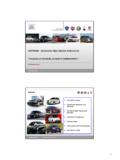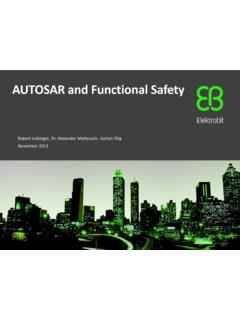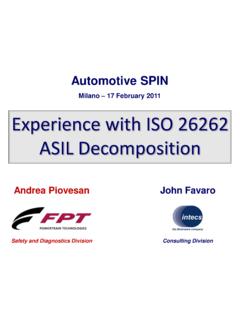Transcription of Functional Safety, Automotive SPICE® and Agile Methodology
1 Functional Safety, Automotive SPICE . and Agile Methodology Automotive SPIN Italia 8th Automotive Software Workshop 17. February 2011. Markus M ller KUGLER MAAG CIE GmbH. Leibnizstr. 11, 70806 Kornwestheim near Stuttgart Tel / Fax +49 (0) 7154 1796 100 / +49 173 678 7338. Agenda Kugler Maag Cie company profile Introductory considerations regarding Agile methods Why use Agile methods? motivation Our understanding of Agile methods Challenges in Automotive regarding the use of Agile methods Disclaimer Best Practices our experience in Automotive Using best practices to apply Agile principles and ASPICE and Functional safety requirements Some examples from the field Potential analysis to estimate cost and benefit Summary About the author.
2 Markus Mueller Married with 2 children Director Operations at Kugler Maag Cie Over 15 years of experience in industry and research projects Assisting medium-size companies as well as international corporations, primarily in the Automotive industry PMI Project Management Professional Very experienced trainer, moderator, and management coach Speaker at conferences and co-author of books Qualification & Experience intacs -certified Principal Assessor and trainer, intacs Advisory Board member, who conducted more than 40 assessments, many of them for OEMs trained more than 150 ISO/IEC 15504 provisional assessors from leading car manufactures (OEMs) and suppliers advised OEM representatives on the development of Automotive SPICE.
3 Project leader of several change and improvement projects based on ISO/IEC 15504 and CMM/CMMI . Providing consultancy, coaching, and active support in several ECU development projects in Automotive project leader for the implementation of a project control office (PCO) in the electronics development of a major car manufacturer, which today controls more than 100 ECU development projects KUGLER MAAG CIE is a service company with recognized expertise in process improvement Facts Customers Founded in 2004, today a team of more Global players, culturally diverse, than 50 recognized experts operating in Specialized on process improvement Europe incl. Italy Expertise in CMMI , ISO 15504/SPICE, North America and Automotive SPICE , IEC 61508/ Functional safety, Asia project /quality /requirements management, change management.
4 Partners & Networks Industries Automotive industry, Financial services, ICT, MBtech Health, telecommunications, and transportation Introductory considerations regarding Agile methods Copyright 2011 KUGLER MAAG CIE. Page 7 - ller - Version A. Why use Agile methods? Motivation Customer requirements are often changing during the development cycle of a project or, even more common, customers don't know their requirements at the start of development, as they are frequently developed in the course of the project Companies often complain that the development cycle is too slow and not flexible enough - they need innovative products with functionality within weeks The development process requires several non value added process steps and work products (from the perspective of the development team).
5 Agile methods are focused on handling these challenges by adapting the development process to continuously changing requirements stabilizing the development process to be able to develop software under these conditions introducing the high productivity of small teams with extensive expertise being quick and economical focusing on added value ( developing only what is required by internal and external customers). Copyright 2011 KUGLER MAAG CIE. Page 8 - ller - Version A. The seven Agile principles 1. Eliminate waste: Waste is everything that does not add value to a product, value as perceived by the customer. 2. Amplify learning: Development is an exercise in discovery, while production is an exercise in reducing variations.
6 For this reason a lean approach to development results in practices that are quite different from lean production practices. 3. Decide as late as possible: Development practices that provide for late decision making are effective in domains that involve uncertainty. 4. Deliver as fast as possible: In development the discovery cycle is critical for learning: Design, implement, feedback, improve. The shorter these cycles are, the more can be learned. Copyright 2011 KUGLER MAAG CIE. Page 9 - ller - Version A. The seven Agile principles 5. Empower the team: Because decisions are made late and execution is fast, it is not possible for a central authority to orchestrate the activities of the workers. 6.
7 Build in integrity: Software with integrity has a coherent architecture, scores high on usability and fitness for purpose, and is maintainable, adaptable and extensible. 7. See the whole: The common good suffers, if people attend first to their own specialized interests. When individuals or organizations are measured by their specialized contribution rather than overall performance, sub- optimization is likely the result. Copyright 2011 KUGLER MAAG CIE. Page 10 - ller - Version A. Our understanding of Agile methods We at Kugler Maag Cie understand Agile methods as a generic term for different software development models such as Scrum, extreme programming, etc We are noticing that the term is increasingly used for a new way of thinking about project management as opposed to traditional, forward-planning project management.
8 Agile means that the management and control of projects is performed in a flexible and dynamic way. Agile emphasises on the positive aspects of less hierarchical leadership. An essential attribute of Agile methods are highly networked, self-reliant, interdisciplinary teams. Also a change from defined to adaptive development processes. We are mainly working with Scrum, but also with KANBAN. Copyright 2011 KUGLER MAAG CIE. Page 11 - ller - Version A. Challenges in Automotive regarding the use of Agile methods ECU development in Automotive requires mature products of high quality, with a long lifetime and a guarantee requires fulfilment of traditional development standards like ISO 26262, Automotive SPICE, ISO/TS 16949, OEM-specific standards.
9 Requires a high degree of product documentation must consider that the development team of an ECU is part of a huge intercompany team that is developing a car (hundreds of companies, thousands of engineers). Agile methods ( SCRUM) do usually not support architectural design integration and test on a system level SCRUM is focusing on software development No/only few statements regarding hardware-software integration or system test No/only few statements regarding planning of required infrastructure like HIL, etc. an independent quality assurance role a complete product documentation Product documentation is perceived as non value added Copyright 2011 KUGLER MAAG CIE. Page 13 - ller - Version A. Disclaimer - before we continue Our recommendations are based on our practical experience in Automotive We have to consider the existing standards and requirements We do not recommend a purely Agile approach, but to integrate Agile elements into existing and proven development cycles, and to take advantage of both worlds Some Agile elements have already proved their worth in Automotive for years Incremental development in general Delivery of increments/samples and validation of these at the supplier and the customer side.
10 Incorporating the return flow of results into the next increment Rough overall release planning, detailed planning only for the next increment Requirements are not fixed at the start, but developed and clarified during development Agile fans will say that this is a boring approach, not considering the pure Agile . principles .. - and they will be right .. - But we do have to consider the Automotive conditions ! Copyright 2011 KUGLER MAAG CIE. Page 14 - ller - Version A. Best Practices our experience in Automotive Copyright 2011 KUGLER MAAG CIE. Page 15 - ller - Version A. Using best practices to apply Sgile principles and ASPICE and Functional Safety requirements Project organisation above the sprint teams Integrate sprints into the car development cycle Define the architecture before the sprints in such a way, that the sprint backlogs can be derived Standards for processes, methods, guidelines, tools, and documentation Independent integration and system tests (outside the sprints).






